Tesco Operations: Applying TQM and Lean Principles for Efficiency
VerifiedAdded on 2023/01/04
|8
|2475
|91
Report
AI Summary
This report provides a comprehensive analysis of Tesco's operations management. It begins with an introduction to the company, its background, and the competitive environment it operates in, including the retail industry and associated pressures. The core of the report examines Tesco's operational processes, applying the 4V model (volume, variety, variation, and visibility) to assess its efficiency and effectiveness. Furthermore, the report explores the application of Total Quality Management (TQM) and Lean principles within Tesco, highlighting how these methodologies can improve processes and customer satisfaction. Finally, the report evaluates the strengths and weaknesses of Tesco's operations, particularly focusing on the production, HR, finance, and marketing departments, and concludes with recommendations for improvement and strategic adjustments to maintain competitiveness and drive growth. The report references several academic sources to support its claims and analysis.
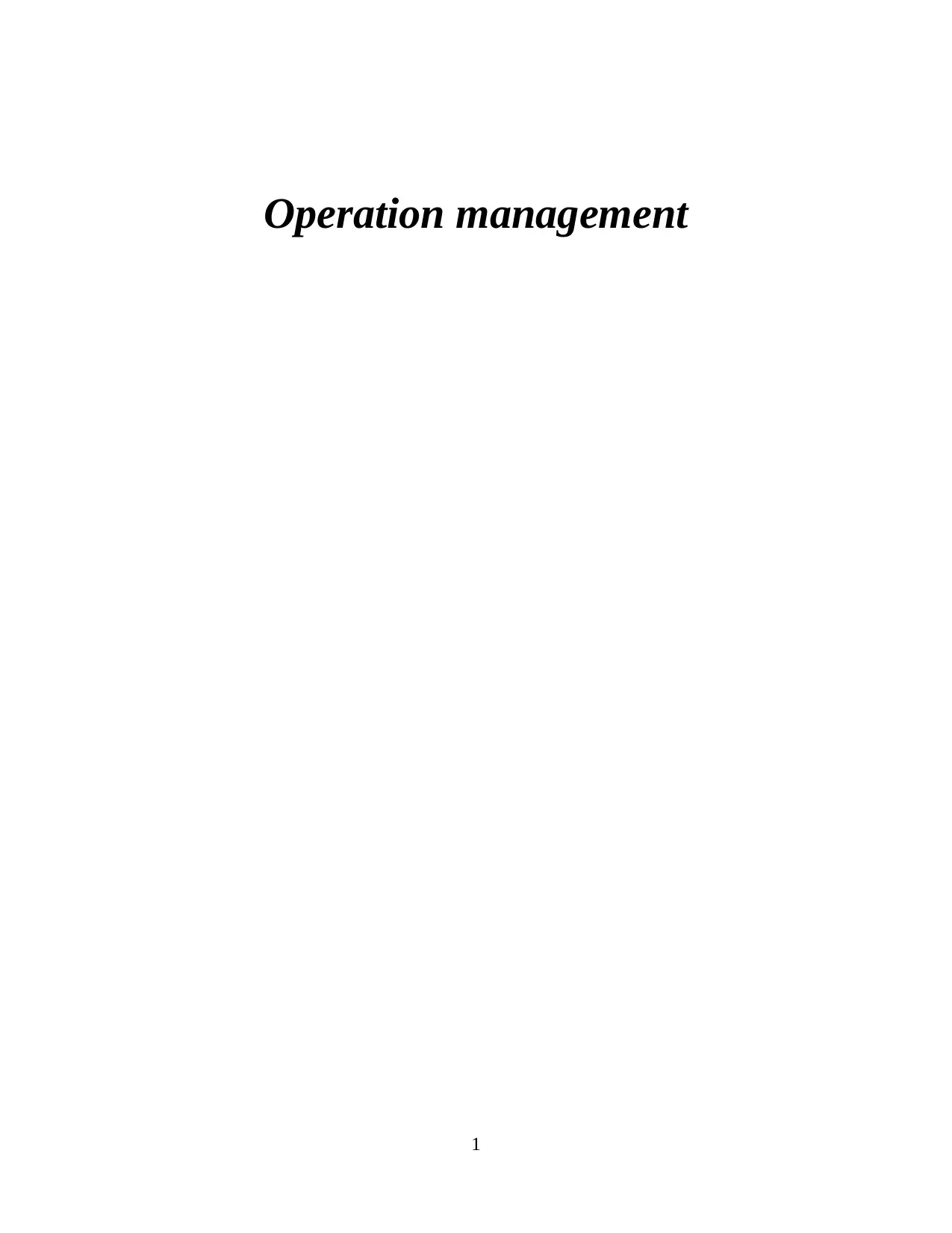
Operation management
1
1
Paraphrase This Document
Need a fresh take? Get an instant paraphrase of this document with our AI Paraphraser
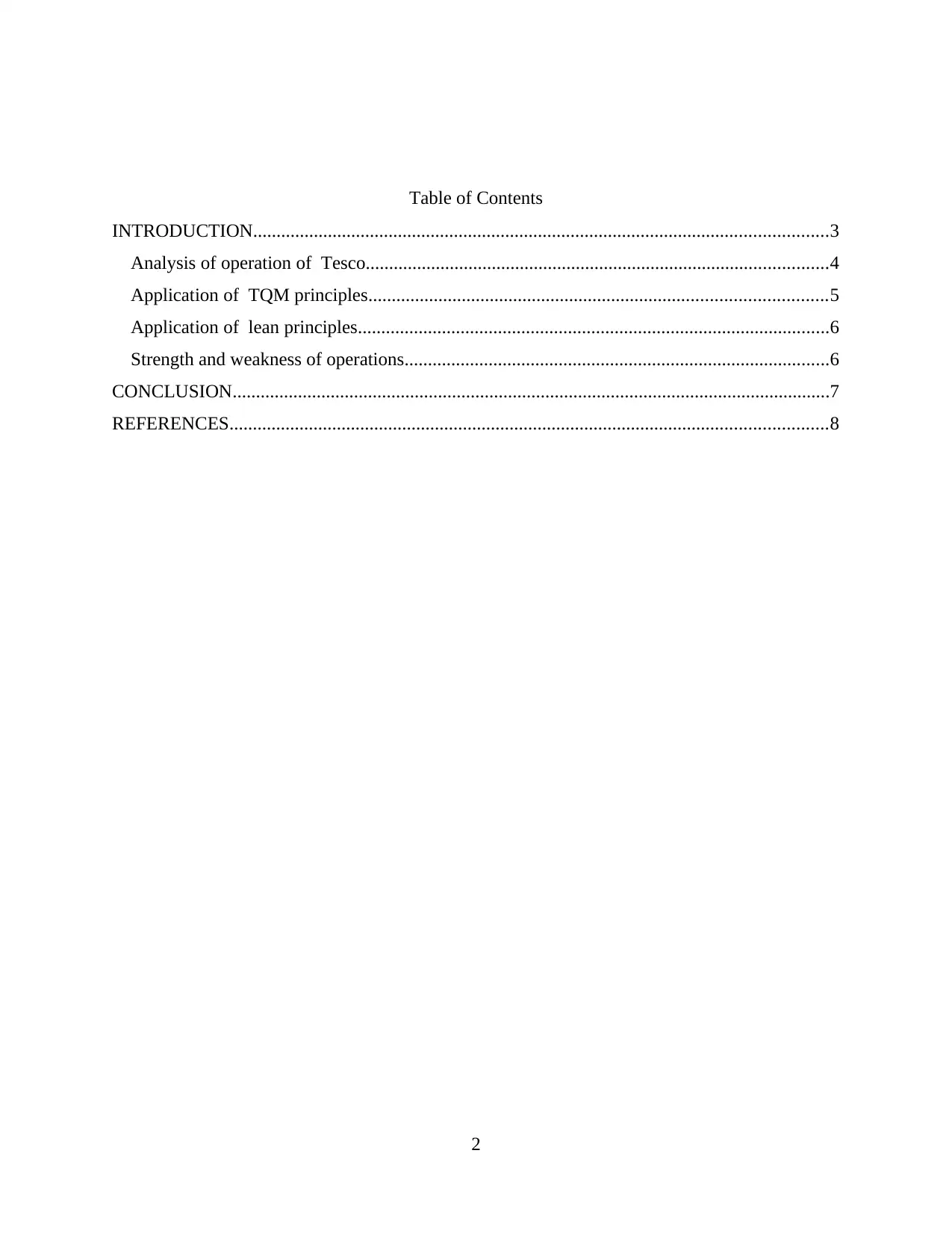
Table of Contents
INTRODUCTION...........................................................................................................................3
Analysis of operation of Tesco...................................................................................................4
Application of TQM principles..................................................................................................5
Application of lean principles.....................................................................................................6
Strength and weakness of operations...........................................................................................6
CONCLUSION................................................................................................................................7
REFERENCES................................................................................................................................8
2
INTRODUCTION...........................................................................................................................3
Analysis of operation of Tesco...................................................................................................4
Application of TQM principles..................................................................................................5
Application of lean principles.....................................................................................................6
Strength and weakness of operations...........................................................................................6
CONCLUSION................................................................................................................................7
REFERENCES................................................................................................................................8
2
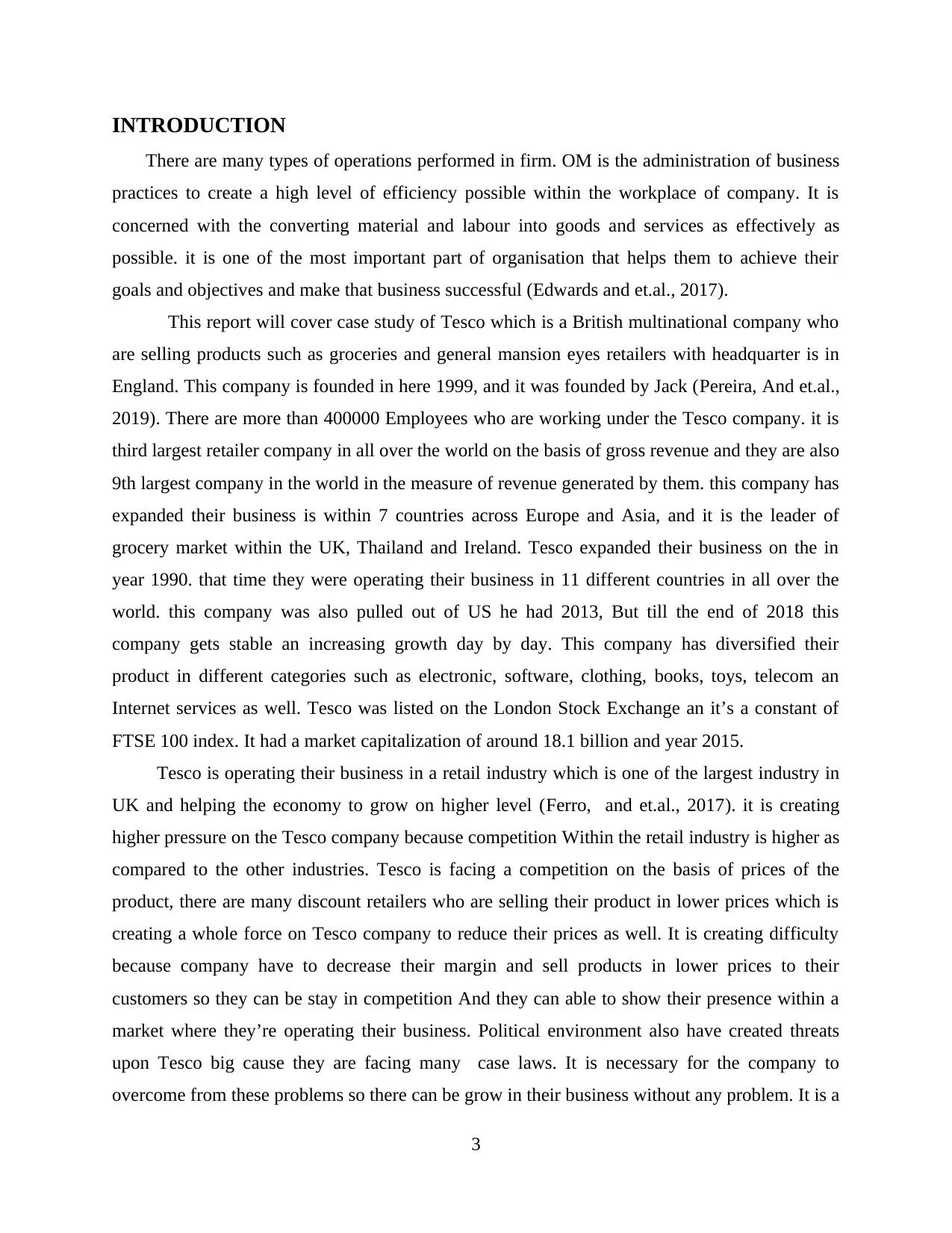
INTRODUCTION
There are many types of operations performed in firm. OM is the administration of business
practices to create a high level of efficiency possible within the workplace of company. It is
concerned with the converting material and labour into goods and services as effectively as
possible. it is one of the most important part of organisation that helps them to achieve their
goals and objectives and make that business successful (Edwards and et.al., 2017).
This report will cover case study of Tesco which is a British multinational company who
are selling products such as groceries and general mansion eyes retailers with headquarter is in
England. This company is founded in here 1999, and it was founded by Jack (Pereira, And et.al.,
2019). There are more than 400000 Employees who are working under the Tesco company. it is
third largest retailer company in all over the world on the basis of gross revenue and they are also
9th largest company in the world in the measure of revenue generated by them. this company has
expanded their business is within 7 countries across Europe and Asia, and it is the leader of
grocery market within the UK, Thailand and Ireland. Tesco expanded their business on the in
year 1990. that time they were operating their business in 11 different countries in all over the
world. this company was also pulled out of US he had 2013, But till the end of 2018 this
company gets stable an increasing growth day by day. This company has diversified their
product in different categories such as electronic, software, clothing, books, toys, telecom an
Internet services as well. Tesco was listed on the London Stock Exchange an it’s a constant of
FTSE 100 index. It had a market capitalization of around 18.1 billion and year 2015.
Tesco is operating their business in a retail industry which is one of the largest industry in
UK and helping the economy to grow on higher level (Ferro, and et.al., 2017). it is creating
higher pressure on the Tesco company because competition Within the retail industry is higher as
compared to the other industries. Tesco is facing a competition on the basis of prices of the
product, there are many discount retailers who are selling their product in lower prices which is
creating a whole force on Tesco company to reduce their prices as well. It is creating difficulty
because company have to decrease their margin and sell products in lower prices to their
customers so they can be stay in competition And they can able to show their presence within a
market where they’re operating their business. Political environment also have created threats
upon Tesco big cause they are facing many case laws. It is necessary for the company to
overcome from these problems so there can be grow in their business without any problem. It is a
3
There are many types of operations performed in firm. OM is the administration of business
practices to create a high level of efficiency possible within the workplace of company. It is
concerned with the converting material and labour into goods and services as effectively as
possible. it is one of the most important part of organisation that helps them to achieve their
goals and objectives and make that business successful (Edwards and et.al., 2017).
This report will cover case study of Tesco which is a British multinational company who
are selling products such as groceries and general mansion eyes retailers with headquarter is in
England. This company is founded in here 1999, and it was founded by Jack (Pereira, And et.al.,
2019). There are more than 400000 Employees who are working under the Tesco company. it is
third largest retailer company in all over the world on the basis of gross revenue and they are also
9th largest company in the world in the measure of revenue generated by them. this company has
expanded their business is within 7 countries across Europe and Asia, and it is the leader of
grocery market within the UK, Thailand and Ireland. Tesco expanded their business on the in
year 1990. that time they were operating their business in 11 different countries in all over the
world. this company was also pulled out of US he had 2013, But till the end of 2018 this
company gets stable an increasing growth day by day. This company has diversified their
product in different categories such as electronic, software, clothing, books, toys, telecom an
Internet services as well. Tesco was listed on the London Stock Exchange an it’s a constant of
FTSE 100 index. It had a market capitalization of around 18.1 billion and year 2015.
Tesco is operating their business in a retail industry which is one of the largest industry in
UK and helping the economy to grow on higher level (Ferro, and et.al., 2017). it is creating
higher pressure on the Tesco company because competition Within the retail industry is higher as
compared to the other industries. Tesco is facing a competition on the basis of prices of the
product, there are many discount retailers who are selling their product in lower prices which is
creating a whole force on Tesco company to reduce their prices as well. It is creating difficulty
because company have to decrease their margin and sell products in lower prices to their
customers so they can be stay in competition And they can able to show their presence within a
market where they’re operating their business. Political environment also have created threats
upon Tesco big cause they are facing many case laws. It is necessary for the company to
overcome from these problems so there can be grow in their business without any problem. It is a
3
⊘ This is a preview!⊘
Do you want full access?
Subscribe today to unlock all pages.

Trusted by 1+ million students worldwide
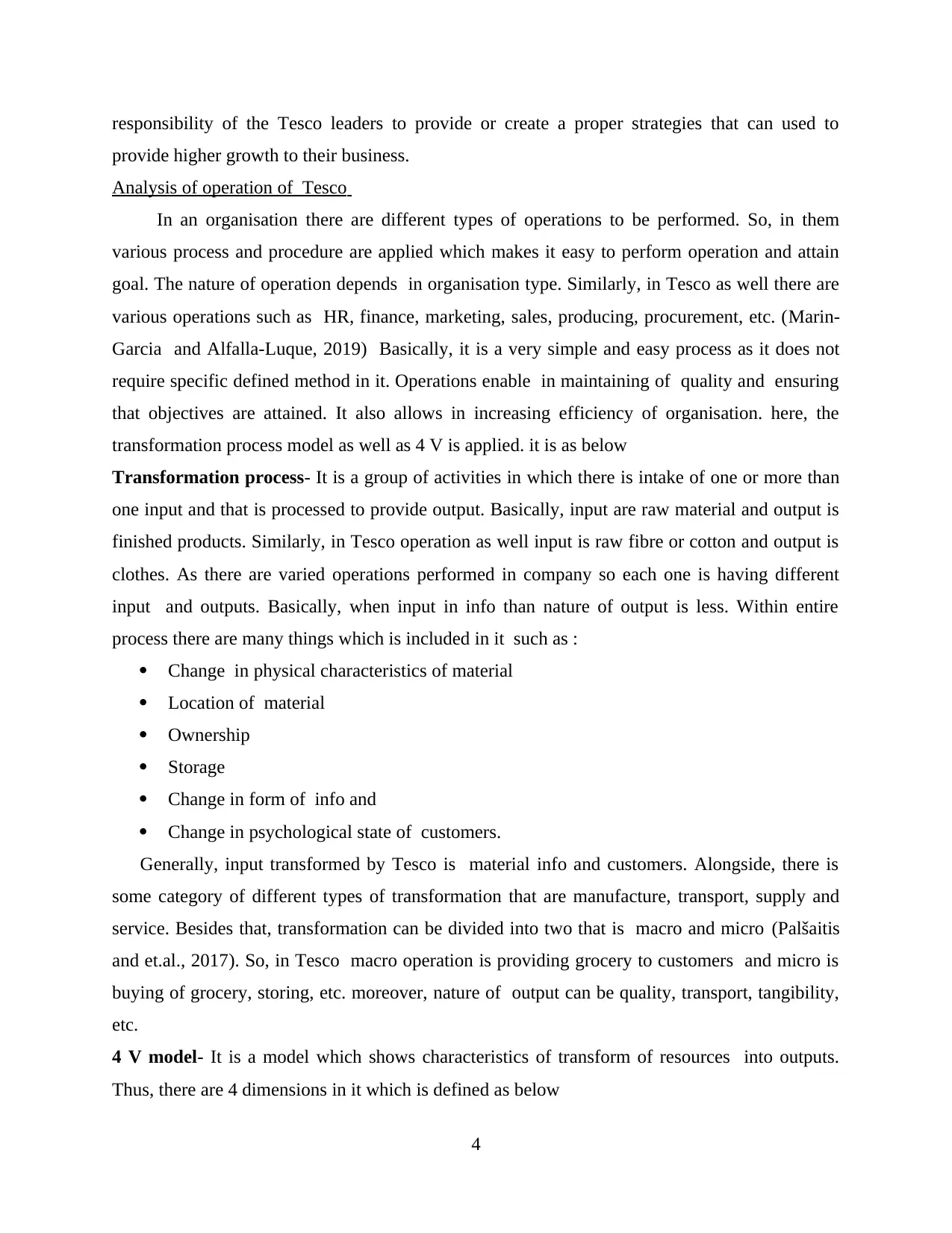
responsibility of the Tesco leaders to provide or create a proper strategies that can used to
provide higher growth to their business.
Analysis of operation of Tesco
In an organisation there are different types of operations to be performed. So, in them
various process and procedure are applied which makes it easy to perform operation and attain
goal. The nature of operation depends in organisation type. Similarly, in Tesco as well there are
various operations such as HR, finance, marketing, sales, producing, procurement, etc. (Marin-
Garcia and Alfalla-Luque, 2019) Basically, it is a very simple and easy process as it does not
require specific defined method in it. Operations enable in maintaining of quality and ensuring
that objectives are attained. It also allows in increasing efficiency of organisation. here, the
transformation process model as well as 4 V is applied. it is as below
Transformation process- It is a group of activities in which there is intake of one or more than
one input and that is processed to provide output. Basically, input are raw material and output is
finished products. Similarly, in Tesco operation as well input is raw fibre or cotton and output is
clothes. As there are varied operations performed in company so each one is having different
input and outputs. Basically, when input in info than nature of output is less. Within entire
process there are many things which is included in it such as :
Change in physical characteristics of material
Location of material
Ownership
Storage
Change in form of info and
Change in psychological state of customers.
Generally, input transformed by Tesco is material info and customers. Alongside, there is
some category of different types of transformation that are manufacture, transport, supply and
service. Besides that, transformation can be divided into two that is macro and micro (Palšaitis
and et.al., 2017). So, in Tesco macro operation is providing grocery to customers and micro is
buying of grocery, storing, etc. moreover, nature of output can be quality, transport, tangibility,
etc.
4 V model- It is a model which shows characteristics of transform of resources into outputs.
Thus, there are 4 dimensions in it which is defined as below
4
provide higher growth to their business.
Analysis of operation of Tesco
In an organisation there are different types of operations to be performed. So, in them
various process and procedure are applied which makes it easy to perform operation and attain
goal. The nature of operation depends in organisation type. Similarly, in Tesco as well there are
various operations such as HR, finance, marketing, sales, producing, procurement, etc. (Marin-
Garcia and Alfalla-Luque, 2019) Basically, it is a very simple and easy process as it does not
require specific defined method in it. Operations enable in maintaining of quality and ensuring
that objectives are attained. It also allows in increasing efficiency of organisation. here, the
transformation process model as well as 4 V is applied. it is as below
Transformation process- It is a group of activities in which there is intake of one or more than
one input and that is processed to provide output. Basically, input are raw material and output is
finished products. Similarly, in Tesco operation as well input is raw fibre or cotton and output is
clothes. As there are varied operations performed in company so each one is having different
input and outputs. Basically, when input in info than nature of output is less. Within entire
process there are many things which is included in it such as :
Change in physical characteristics of material
Location of material
Ownership
Storage
Change in form of info and
Change in psychological state of customers.
Generally, input transformed by Tesco is material info and customers. Alongside, there is
some category of different types of transformation that are manufacture, transport, supply and
service. Besides that, transformation can be divided into two that is macro and micro (Palšaitis
and et.al., 2017). So, in Tesco macro operation is providing grocery to customers and micro is
buying of grocery, storing, etc. moreover, nature of output can be quality, transport, tangibility,
etc.
4 V model- It is a model which shows characteristics of transform of resources into outputs.
Thus, there are 4 dimensions in it which is defined as below
4
Paraphrase This Document
Need a fresh take? Get an instant paraphrase of this document with our AI Paraphraser
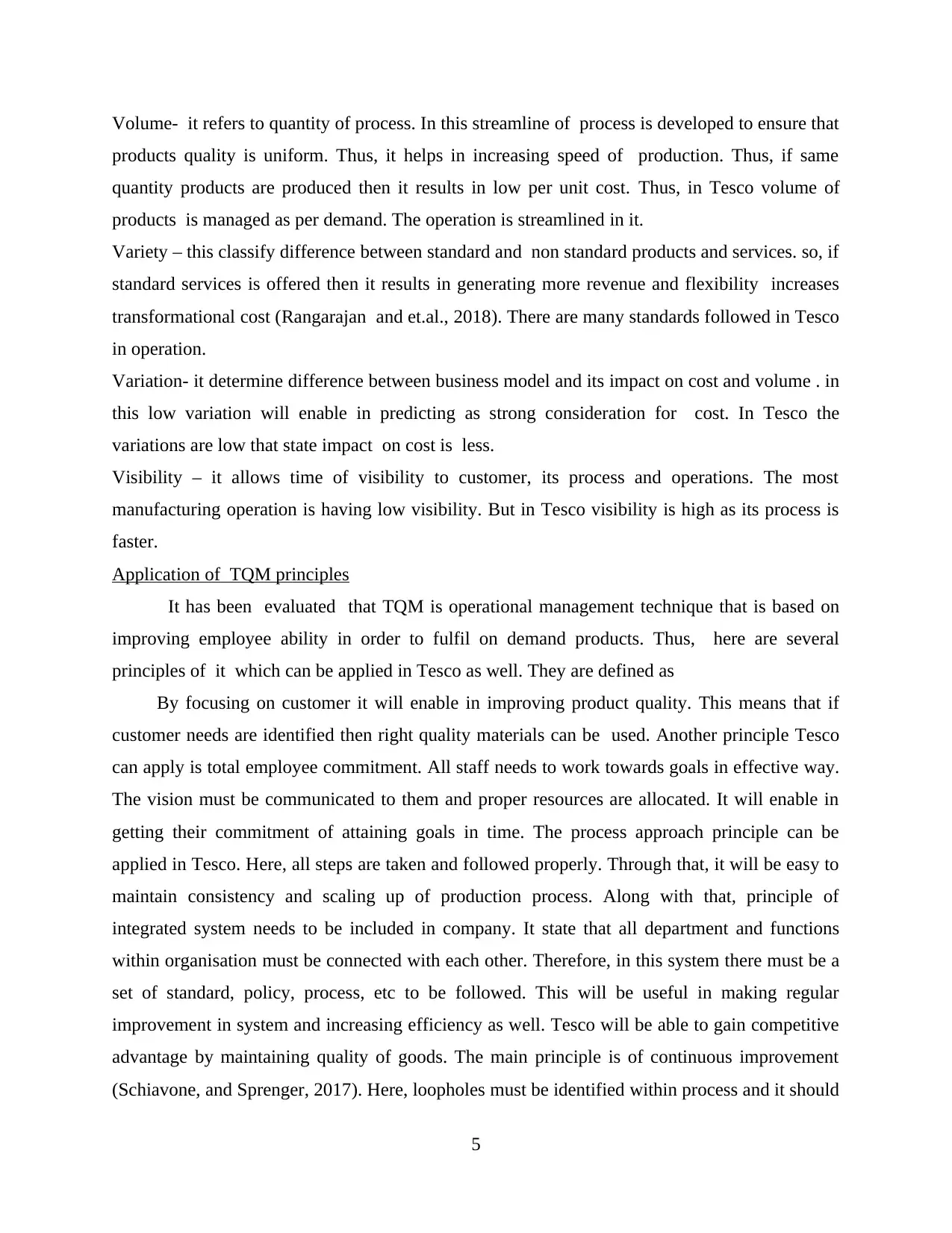
Volume- it refers to quantity of process. In this streamline of process is developed to ensure that
products quality is uniform. Thus, it helps in increasing speed of production. Thus, if same
quantity products are produced then it results in low per unit cost. Thus, in Tesco volume of
products is managed as per demand. The operation is streamlined in it.
Variety – this classify difference between standard and non standard products and services. so, if
standard services is offered then it results in generating more revenue and flexibility increases
transformational cost (Rangarajan and et.al., 2018). There are many standards followed in Tesco
in operation.
Variation- it determine difference between business model and its impact on cost and volume . in
this low variation will enable in predicting as strong consideration for cost. In Tesco the
variations are low that state impact on cost is less.
Visibility – it allows time of visibility to customer, its process and operations. The most
manufacturing operation is having low visibility. But in Tesco visibility is high as its process is
faster.
Application of TQM principles
It has been evaluated that TQM is operational management technique that is based on
improving employee ability in order to fulfil on demand products. Thus, here are several
principles of it which can be applied in Tesco as well. They are defined as
By focusing on customer it will enable in improving product quality. This means that if
customer needs are identified then right quality materials can be used. Another principle Tesco
can apply is total employee commitment. All staff needs to work towards goals in effective way.
The vision must be communicated to them and proper resources are allocated. It will enable in
getting their commitment of attaining goals in time. The process approach principle can be
applied in Tesco. Here, all steps are taken and followed properly. Through that, it will be easy to
maintain consistency and scaling up of production process. Along with that, principle of
integrated system needs to be included in company. It state that all department and functions
within organisation must be connected with each other. Therefore, in this system there must be a
set of standard, policy, process, etc to be followed. This will be useful in making regular
improvement in system and increasing efficiency as well. Tesco will be able to gain competitive
advantage by maintaining quality of goods. The main principle is of continuous improvement
(Schiavone, and Sprenger, 2017). Here, loopholes must be identified within process and it should
5
products quality is uniform. Thus, it helps in increasing speed of production. Thus, if same
quantity products are produced then it results in low per unit cost. Thus, in Tesco volume of
products is managed as per demand. The operation is streamlined in it.
Variety – this classify difference between standard and non standard products and services. so, if
standard services is offered then it results in generating more revenue and flexibility increases
transformational cost (Rangarajan and et.al., 2018). There are many standards followed in Tesco
in operation.
Variation- it determine difference between business model and its impact on cost and volume . in
this low variation will enable in predicting as strong consideration for cost. In Tesco the
variations are low that state impact on cost is less.
Visibility – it allows time of visibility to customer, its process and operations. The most
manufacturing operation is having low visibility. But in Tesco visibility is high as its process is
faster.
Application of TQM principles
It has been evaluated that TQM is operational management technique that is based on
improving employee ability in order to fulfil on demand products. Thus, here are several
principles of it which can be applied in Tesco as well. They are defined as
By focusing on customer it will enable in improving product quality. This means that if
customer needs are identified then right quality materials can be used. Another principle Tesco
can apply is total employee commitment. All staff needs to work towards goals in effective way.
The vision must be communicated to them and proper resources are allocated. It will enable in
getting their commitment of attaining goals in time. The process approach principle can be
applied in Tesco. Here, all steps are taken and followed properly. Through that, it will be easy to
maintain consistency and scaling up of production process. Along with that, principle of
integrated system needs to be included in company. It state that all department and functions
within organisation must be connected with each other. Therefore, in this system there must be a
set of standard, policy, process, etc to be followed. This will be useful in making regular
improvement in system and increasing efficiency as well. Tesco will be able to gain competitive
advantage by maintaining quality of goods. The main principle is of continuous improvement
(Schiavone, and Sprenger, 2017). Here, loopholes must be identified within process and it should
5
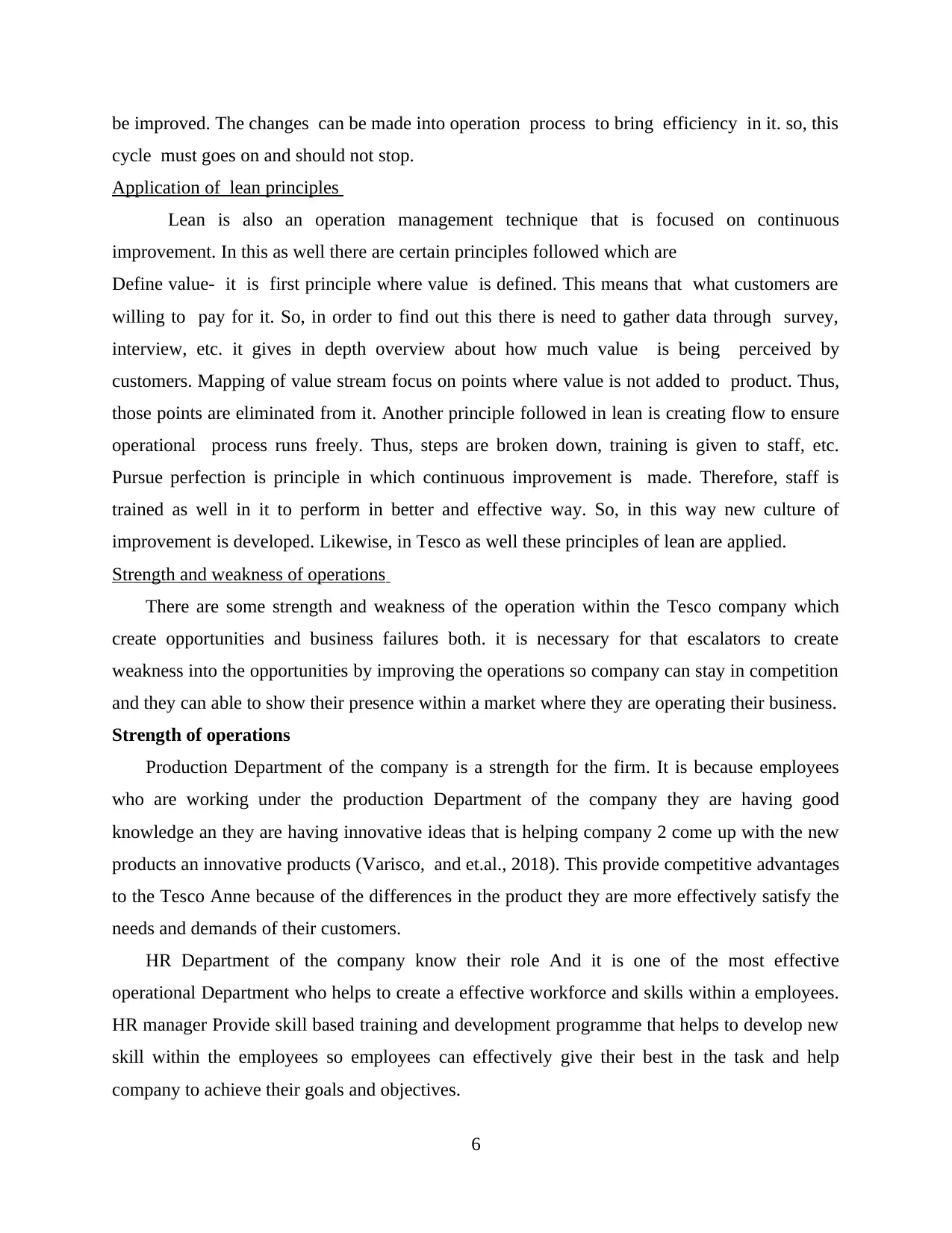
be improved. The changes can be made into operation process to bring efficiency in it. so, this
cycle must goes on and should not stop.
Application of lean principles
Lean is also an operation management technique that is focused on continuous
improvement. In this as well there are certain principles followed which are
Define value- it is first principle where value is defined. This means that what customers are
willing to pay for it. So, in order to find out this there is need to gather data through survey,
interview, etc. it gives in depth overview about how much value is being perceived by
customers. Mapping of value stream focus on points where value is not added to product. Thus,
those points are eliminated from it. Another principle followed in lean is creating flow to ensure
operational process runs freely. Thus, steps are broken down, training is given to staff, etc.
Pursue perfection is principle in which continuous improvement is made. Therefore, staff is
trained as well in it to perform in better and effective way. So, in this way new culture of
improvement is developed. Likewise, in Tesco as well these principles of lean are applied.
Strength and weakness of operations
There are some strength and weakness of the operation within the Tesco company which
create opportunities and business failures both. it is necessary for that escalators to create
weakness into the opportunities by improving the operations so company can stay in competition
and they can able to show their presence within a market where they are operating their business.
Strength of operations
Production Department of the company is a strength for the firm. It is because employees
who are working under the production Department of the company they are having good
knowledge an they are having innovative ideas that is helping company 2 come up with the new
products an innovative products (Varisco, and et.al., 2018). This provide competitive advantages
to the Tesco Anne because of the differences in the product they are more effectively satisfy the
needs and demands of their customers.
HR Department of the company know their role And it is one of the most effective
operational Department who helps to create a effective workforce and skills within a employees.
HR manager Provide skill based training and development programme that helps to develop new
skill within the employees so employees can effectively give their best in the task and help
company to achieve their goals and objectives.
6
cycle must goes on and should not stop.
Application of lean principles
Lean is also an operation management technique that is focused on continuous
improvement. In this as well there are certain principles followed which are
Define value- it is first principle where value is defined. This means that what customers are
willing to pay for it. So, in order to find out this there is need to gather data through survey,
interview, etc. it gives in depth overview about how much value is being perceived by
customers. Mapping of value stream focus on points where value is not added to product. Thus,
those points are eliminated from it. Another principle followed in lean is creating flow to ensure
operational process runs freely. Thus, steps are broken down, training is given to staff, etc.
Pursue perfection is principle in which continuous improvement is made. Therefore, staff is
trained as well in it to perform in better and effective way. So, in this way new culture of
improvement is developed. Likewise, in Tesco as well these principles of lean are applied.
Strength and weakness of operations
There are some strength and weakness of the operation within the Tesco company which
create opportunities and business failures both. it is necessary for that escalators to create
weakness into the opportunities by improving the operations so company can stay in competition
and they can able to show their presence within a market where they are operating their business.
Strength of operations
Production Department of the company is a strength for the firm. It is because employees
who are working under the production Department of the company they are having good
knowledge an they are having innovative ideas that is helping company 2 come up with the new
products an innovative products (Varisco, and et.al., 2018). This provide competitive advantages
to the Tesco Anne because of the differences in the product they are more effectively satisfy the
needs and demands of their customers.
HR Department of the company know their role And it is one of the most effective
operational Department who helps to create a effective workforce and skills within a employees.
HR manager Provide skill based training and development programme that helps to develop new
skill within the employees so employees can effectively give their best in the task and help
company to achieve their goals and objectives.
6
⊘ This is a preview!⊘
Do you want full access?
Subscribe today to unlock all pages.

Trusted by 1+ million students worldwide

Weakness in operations
Finance Department company Is weaker and company is not effectively using the financial
resources. company can implement and use the resources properly within a different Department
but lack of utilisation of resources is creating your thread for the Tesco company (Visvikis, and
Panayides, 2017). It is necessary for the finance manager of the company to use financial
resources properly so they can create opportunity for the business to grow more and achieve
success.
Marketing operations are weaker and they need to be improved more. marketing team is not
able to run the campaign within the market effectively and they are not able to attract the
customers to buy the product from the Tesco company. it is necessary for the hr managers to
provide training to their marketing team so they can learn and use the new tools of marketing and
effectively use to attract the customers to buy the product from Tesco company and help them to
grow their business effectively (Zhu. and et.al., 2018). employees so employees can effectively
give their best in the task and help company to achieve their goals and objectives.
CONCLUSION
It can be summarized that in Tesco company and identify the effectiveness of operational
management within their workplace. It has been provided brief information about the company
including the environment and pressure they are facing within the retail industry. This report has
been analysed the operation within the company by using the 4V model. In the end of this report
has been identify the major strength and weakness within the companies operation To provide a
competitive advantages and create weakness into opportunities.
7
Finance Department company Is weaker and company is not effectively using the financial
resources. company can implement and use the resources properly within a different Department
but lack of utilisation of resources is creating your thread for the Tesco company (Visvikis, and
Panayides, 2017). It is necessary for the finance manager of the company to use financial
resources properly so they can create opportunity for the business to grow more and achieve
success.
Marketing operations are weaker and they need to be improved more. marketing team is not
able to run the campaign within the market effectively and they are not able to attract the
customers to buy the product from the Tesco company. it is necessary for the hr managers to
provide training to their marketing team so they can learn and use the new tools of marketing and
effectively use to attract the customers to buy the product from Tesco company and help them to
grow their business effectively (Zhu. and et.al., 2018). employees so employees can effectively
give their best in the task and help company to achieve their goals and objectives.
CONCLUSION
It can be summarized that in Tesco company and identify the effectiveness of operational
management within their workplace. It has been provided brief information about the company
including the environment and pressure they are facing within the retail industry. This report has
been analysed the operation within the company by using the 4V model. In the end of this report
has been identify the major strength and weakness within the companies operation To provide a
competitive advantages and create weakness into opportunities.
7
Paraphrase This Document
Need a fresh take? Get an instant paraphrase of this document with our AI Paraphraser
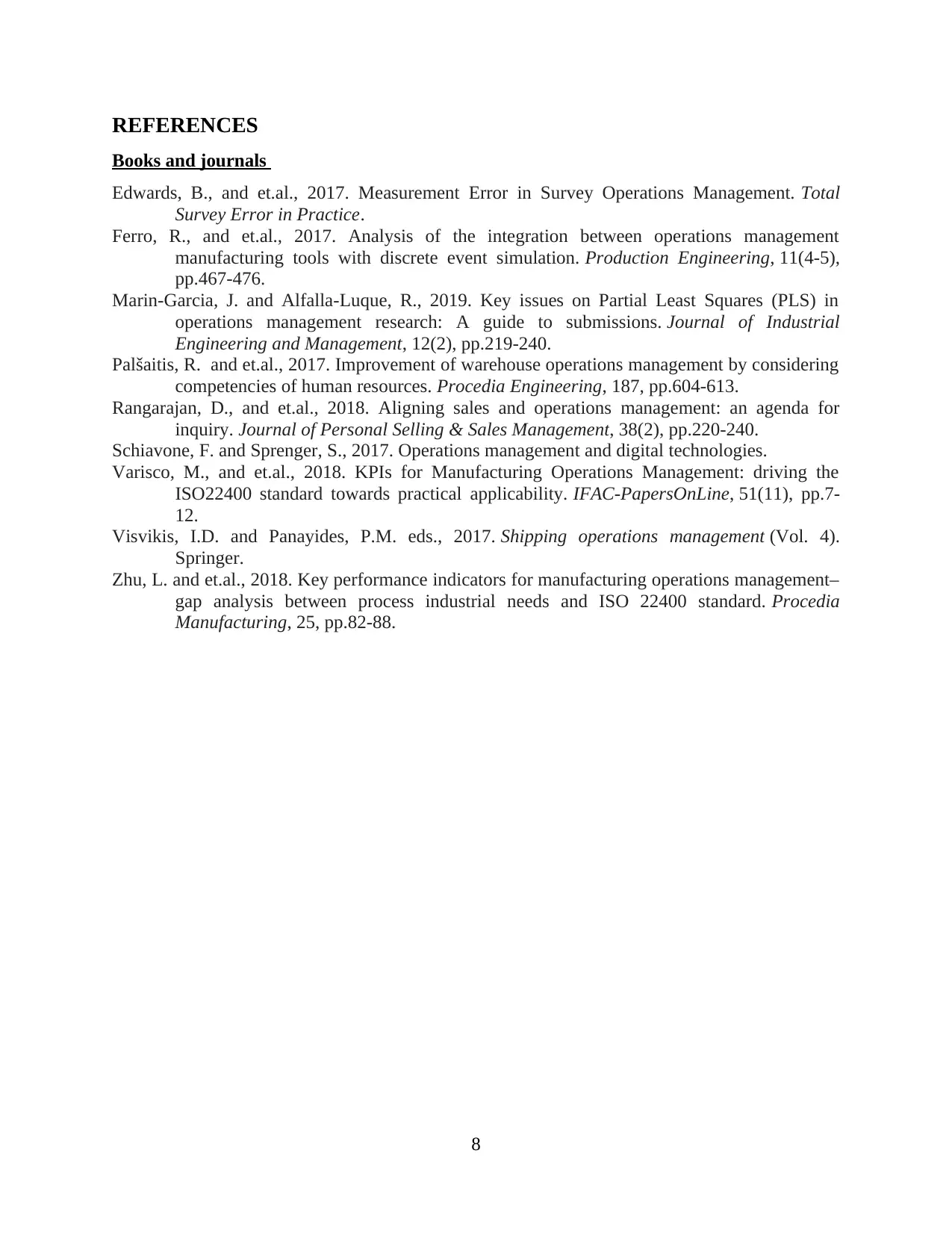
REFERENCES
Books and journals
Edwards, B., and et.al., 2017. Measurement Error in Survey Operations Management. Total
Survey Error in Practice.
Ferro, R., and et.al., 2017. Analysis of the integration between operations management
manufacturing tools with discrete event simulation. Production Engineering, 11(4-5),
pp.467-476.
Marin-Garcia, J. and Alfalla-Luque, R., 2019. Key issues on Partial Least Squares (PLS) in
operations management research: A guide to submissions. Journal of Industrial
Engineering and Management, 12(2), pp.219-240.
Palšaitis, R. and et.al., 2017. Improvement of warehouse operations management by considering
competencies of human resources. Procedia Engineering, 187, pp.604-613.
Rangarajan, D., and et.al., 2018. Aligning sales and operations management: an agenda for
inquiry. Journal of Personal Selling & Sales Management, 38(2), pp.220-240.
Schiavone, F. and Sprenger, S., 2017. Operations management and digital technologies.
Varisco, M., and et.al., 2018. KPIs for Manufacturing Operations Management: driving the
ISO22400 standard towards practical applicability. IFAC-PapersOnLine, 51(11), pp.7-
12.
Visvikis, I.D. and Panayides, P.M. eds., 2017. Shipping operations management (Vol. 4).
Springer.
Zhu, L. and et.al., 2018. Key performance indicators for manufacturing operations management–
gap analysis between process industrial needs and ISO 22400 standard. Procedia
Manufacturing, 25, pp.82-88.
8
Books and journals
Edwards, B., and et.al., 2017. Measurement Error in Survey Operations Management. Total
Survey Error in Practice.
Ferro, R., and et.al., 2017. Analysis of the integration between operations management
manufacturing tools with discrete event simulation. Production Engineering, 11(4-5),
pp.467-476.
Marin-Garcia, J. and Alfalla-Luque, R., 2019. Key issues on Partial Least Squares (PLS) in
operations management research: A guide to submissions. Journal of Industrial
Engineering and Management, 12(2), pp.219-240.
Palšaitis, R. and et.al., 2017. Improvement of warehouse operations management by considering
competencies of human resources. Procedia Engineering, 187, pp.604-613.
Rangarajan, D., and et.al., 2018. Aligning sales and operations management: an agenda for
inquiry. Journal of Personal Selling & Sales Management, 38(2), pp.220-240.
Schiavone, F. and Sprenger, S., 2017. Operations management and digital technologies.
Varisco, M., and et.al., 2018. KPIs for Manufacturing Operations Management: driving the
ISO22400 standard towards practical applicability. IFAC-PapersOnLine, 51(11), pp.7-
12.
Visvikis, I.D. and Panayides, P.M. eds., 2017. Shipping operations management (Vol. 4).
Springer.
Zhu, L. and et.al., 2018. Key performance indicators for manufacturing operations management–
gap analysis between process industrial needs and ISO 22400 standard. Procedia
Manufacturing, 25, pp.82-88.
8
1 out of 8
Related Documents
Your All-in-One AI-Powered Toolkit for Academic Success.
+13062052269
info@desklib.com
Available 24*7 on WhatsApp / Email
![[object Object]](/_next/static/media/star-bottom.7253800d.svg)
Unlock your academic potential
Copyright © 2020–2025 A2Z Services. All Rights Reserved. Developed and managed by ZUCOL.



